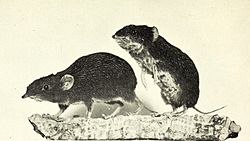| Neotetracus | |
|---|---|
 | |
| Scientific classification | |
| Kingdom: | Animalia |
| Phylum: | Chordata |
| Class: | Mammalia |
| Order: | Eulipotyphla |
| Family: | Erinaceidae |
| Subfamily: | Galericinae |
| Genus: | Neotetracus Trouessart, 1909 |
| Type species | |
| Neotetracus sinensis Trouessart, 1909 | |
| Species | |
Neotetracus is a genus of gymnure that contains a single extant species, the shrew gymnure (Neotetracus sinensis) of China and Southeast Asia.
Another fossil species is also known from the Miocene of Thailand, Neotetracus butleri . [1] [2]